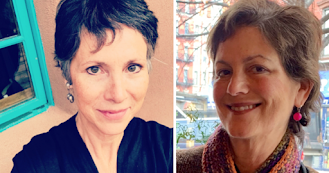On Saturday, October 11, Amy was a panelist on “The Relevance of Art in an
Age of Global Warming” at Moore College of Art and Design in Philadelphia, PA. The panel was sponsored by Philadelphia Sculptors and the participants were Amy Lipton, Andrew Chartier, Andrea Polli, Ben Pinder
and Stacy Levy. The panel discussion was moderated by Canadian environmental arts writer
John Grande who has written numerous books on the relationship of artists to nature and landscape such as “Balance: Art and Nature” (a newly expanded edition by Black Rose Books in, 2004), “Intertwining: Landscape, Technology, Issues, Artists” and his most recent book, “Dialogues in Diversity: Marginal to Mainstream” published in Italy in 2007 by Pari Publishing.
This panel had four artist presenters, each whose work involved very different processes and formal strategies. Amy presented the work of New York artist Eve Mosher and showed a documentary film on her project
High Water Line.
HighWaterLine was a visual and perfomance artwork which took place on the New York city waterfront and created an immediate visual and local understanding of the affects of climate change. Eve marked the 10-feet above sea level line by drawing a blue chalk line and installing illuminated beacons along that line in public parks. The line marks the extent of increased flooding brought on by stronger and more frequent storms as a result of climate change. During the summer of 2007, Eve walked, chalked and marked almost 70 miles of coastline. She was out in the public creating the work, and had conversations with community members and passers by about climate change and its potential impacts.

Andrew Chartier, a Canadian artist in the corresponding exhibition Global Warming at the Ice Box presented a documentary film on his performance which involved standing outdoors at the intersection of busy Philadelphia streets wearing a haz-mat worker suit and operating a machine composed of various metal parts including a bicycle wheel, called the “Dioxigrapher”. Unassuming in his garb and methodically, Chartier walks his gadget into traffic and holds it up to the exhaust pipes of cars sitting idling at stoplights. This humorous sucking action seemed almost pornographic and gave the viewer a feeling of being part of a surveillance system. After sucking up car fumes, the Dioxigrapher becomes activated and draws chalk circles on the street near the cars. This work had an uncanny relationship to Mosher’s High Water Line, though these two artists had no previous knowledge of one another. This proves that artists in very different parts of the world are thinking similarly in terms of artworks that engage the public directly to think about their day to day lives and the impact climate change may have on them.
Andrea Polli presented sound, images, film, graphs and charts from her recent National Science Foundation funded residency in Antartica. Polli’s new work, Sonic Ant

arctica is a series of natural and technological sound recordings and sonifications made by artists, scientists and sound enthusiasts who have lived in Antarctica.
"When most people picture Antarctica, on the few occasions that they even think about that frozen continent, they probably think of a bare, eerily silent, and unforgivable landscape. Andrea Polli, on the other hand, pictures a land of mystery and sound as well as a saving grace for atmospheric scientists all over the world... As multiple projectors and television screens played footage of the Antarctic landscape and the scientists working in such a landscape, Polli played audio clips that illustrate the unusual sort of soundscape that can be found in such a locale”.
Ben Pinder, also in the exhibition
Global Warming at the Ice Box is a recent MFA graduate from Pratt Institute. Pinder took a humorous approach with his performance titled The New Manifest Destiny, The Conquest of Antarctica, How Global Warming can be Good for America. This presentation was performed in the tongue-in-cheek style of the Colbert Report and had Pinder promoting, “A New America, 2048,” where Antarctica is turned into a super productive resource rich commodity producing continent, claimed and developed by the U.S. as a “positive” result of Global Warming’s effect.
Stacy Levy presented images of her various public projects and exhibitions and spoke about her abiding interest in the natural world. All of her works combine art and science. They become a vehicle for translating the patterns and processes of the natural world into the language of human understanding. “I try to design a project so that the site tells the ecological story of itself. In my work, I mesh the clarity of diagrams, the beauty of natural forms and the visceral sense of the site. My art creates a comprehensible visual metaphor for an otherwise invisible natural process.” Levy works extensively with engineers, architects and landscape architects on most of her public projects. She frequently collaborates with scientists who are experts in the particular aspect of nature she’s investigating.
A DVD of the panel discussion "The Relevance of Art in an Age of Global Warming" is available for purchase. Please contact lesliekaufman@verizon.net
Click
HERE for a review of the Ice Box exhibition.














